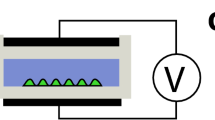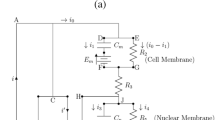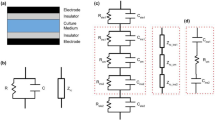Abstract
Membrane capacitance and transmembrane potential are sensitive to the proximity of neighboring biological cells which eventually induces anisotropic perturbation of the local electric field distribution in a cell assembly and/or a tissue. The development of robust and reliable multiphysics approaches is essential to solve the challenge of analyzing proximity-induced capacitance coupling (CC) between cells. In this study, we ask to what extent this CC is a minor perturbation on the individual cells or whether it can fundamentally affect bio-electromechanical cues. A key component of our continuum electromechanical analysis is the consideration of elastic models of cells under steady state electric field excitation to characterize electrodeformation (ED). Analyzing the difference between the ED force for a pair of cells and its counterpart for a single reference cell allows us to determine a separation distance-orientation angle diagram providing evidence of a separation distance beyond which the electrostatic interactions between a pair of biological cells become inconsequential for the ED. An attenuation–amplification transition of ED force in this diagram suggests that anisotropy induced by the orientation angle of the cell pair relative to the applied electric field direction has a significant influence on ED and CC. We furthermore observe that the shape of this diagram changes when extracellular conductivity is varied. The results obtained are then contrasted with the corresponding diagrams of similar cell configurations under an oscillating electric field excitation below and above the α-dispersion frequency. This investigation may provide new opportunities for further assessment of electromechanical properties of engineered tissues.





Similar content being viewed by others
References
Balint R, Cassidy NJ, Cartmell SH (2013) Electrical stimulation: a novel tool for tissue engineering. Tissue Eng Part B Rev 19:48–57
Bazhenov M, Lonjers P, Skorheim S, Bédard C, Destexhe A (2011) Non-homogeneous extracellular resistivity affects the current-source density profiles of up-down state oscillations. Phil Trans R Soc A 369:3802–3819
Bédard C, Kröger H, Destexhe A (2004) Modeling extracellular field potentials and the frequency-filtering properties of extracellular space. Biophys J 86:1829–1842
C. Brosseau, E. Sabri (2020) A portrait of Nature’s ultimate stretchable resistor-capacitor network: cell membrane”, unpublished.
Chen C, Bai X, Ding Y, Lee IS (2019) Electrical stimulation as a novel tool for regulating cell behavior behavior in tissue engineering. Biomater Res 23:1–12
Collinsworth AM, Torgan CE, Nagda SN, Rajalingam RJ, Kraus WE, Truskey GA (2000) Orientation and length of mammalian skeletal myocytes in response to a unidirectional stretch. Cell Tissue Res 302:243–251
Dermol-Černe J, Batista Napotnik T, Reberšek M, Miklavčič D (2020) Short microsecond pulses achieve homogeneous electroporation of elongated biological cells irrespective of their orientation in electric field. Sci Rep 10:9149
Di Biasio A, Ambrosone L, Cametti C (2010) The dielectric behavior of nonspherical biological cell suspensions: an analytic approach. Biophys J 99:163–174
Essone Mezeme M, Pucihar G, Pavlin M, Brosseau C, Miklavčič D (2012) A numerical analysis of multicellular environment for modeling tissue electroporation. Appl Phys Lett 100:143701(1)–143701(4)
Essone Mezeme M, Kranjc M, Bajd F, Sersa I, Brosseau C, Miklavčič D (2012) Assessing how electroporation affects the effective conductivity tensor of biological tissues. Appl Phys Lett 101:213702(1)–213702(4)
Fazelkhah,. Braasch K, Afshar S, Salimi E, Butler M, Bridges G, Thomson D (2018) Quantitative model for ion transport and cytoplasm conductivity of Chinese hamster ovary cells. Sci Rep 8 : 17818
Foster KR, Schwan HP (1989) Dielectric properties of Tissues and biological materials: a critical review. Crit Rev Biomed Eng 17:25–104
Genet S, Costalat R, Burger J (2001) The influence of plasma membrane electrostatic properties on the stability of cell ionic composition. Biophys J 81:2442–2457
Goldberg E, Suarez C, Alfonso M, Marchese J, Soba A, Marshall G (2018) Cell membrane electroporation modeling: a multiphysics approach. Bioelectrochemistry 124:28–39
Gowrishankar TR, Weaver JC (2003) An approach to electrical modeling of single and multiple cells. Proc Natl Acad Sci USA 100:3203–3208
Ikada Y (2006) Challenges in tissue engineering. J R Soc Interface 3:589–601
Krueger S, Achilles S, Zimmermann J, Tischer T, Bader R, Jonitz-Heincke A (2019) Re-differentiation capacity of human chondrocytes in vitro following electrical stimulation with capacitively coupled fields. J Clin Med 8:1771
Kürschner M, Nielsen K, Andersen C, Sukhorukov VL, Schenk WA, Benz R, Zimmermann U (1998) Cells studied by electrorotation. Biophys J 74:3031–3043
Li J, Tan W, Yu M, Lin H (2013) The effect of extracellular conductivity on electroporation-mediated molecular delivery. Biochim Biophys Acta 1828:461–470
Livne EB, Geiger B (2014) Cell reorientation under cyclic stretching. Nat Commun 5:3938
Lojewska Z, Farkas DL, Ehrenberg B, Loew LM (1989) Analysis of the effect of medium and membrane conductance on the amplitude and kinetics of membrane potentials induced by externally applied electric fields. Biophys J 56:121–128
Lorich DG, Brighton CT, Gupta R, Corsetti JR, Levine SE, Gelb ID, Seldes R, Pollack SR (1998) Biochemical pathway mediating the response of bone cells to capacitive coupling. Clin Orthop Relat Res 350:246–256
McCaig CD, Rajnicek AM, Song B, Zhao M (2005) Controlling cell behavior electrically: current views and future potential. Physiol Rev 85:943–978
Mescia L, Chiapperino MA, Bia P, Lamacchia CM, Gielis J, Caratelli D (2019) Design of electroporation process in irregularly shaped multicellular systems. Electronics 8:37(1)–37(17)
Müller KJ, Sukhorukov VL, Zimmermann U (2001) Reversible electropermeabilization of mammalian cells by high-intensity, ultra-short pulses of submicrosecond duration. J Membr Biol 184:161–170
COMSOL Multiphysics version 5.5.
Murovec T, Brosseau C (2013) Anisotropy of the crossover between electrostatic attraction and repulsion of biological cells. Appl Phys Lett 103:193702
Murovec T, Brosseau C (2015) Spectral fingerprint of electrostatic forces between biological cells. Phys Rev E 92:042717
Murovec T, Sweeney DC, Latouche E, Davalos RV, Brosseau C (2016) Modeling of transmembrane potential in realistic multicellular structures before electroporation. Biophys J 111:2286–2295
Novickji V, Rembialkowska N, Staigvila G, Kulbacka J (2020) Effects of extracellular medium conductivity on cell response in the context of sub-microsecond range calcium electroporation. Sci Rep 10:3718
Nuccitelli R (2003) Endogenous electric fields in embryos during development, regeneration and wound healing. Radiat Prot Dosimetry 106:375–383
Picas L, Rico F, Scheuring S (2012) Direct measurement of the mechanical properties of lipid phases in supported bilayers. Biophys J 102:L01–L03
Plaksin M, Kimmel E, Shoham S (2017) Revisiting the theoretical cell membrane thermal capacitance response. Nat Commun 8:1432
Sabri E, Lasquellec S, Brosseau C (2020) Electromechanical modeling of the transmembrane potential-dependent cell membrane capacitance. Appl Phys Lett 117:043701
Shamoon D, Lasquellec S, Brosseau C (2019) A muliphysics analysis of the strain energy in multicellular environments. Appl Phys Lett 115:043701
Shapiro MG, Homma K, Villarreal S, Richter C-P, Bezanilla F (2017) Reply to ‘Revisiting the theoretical cell membrane thermal capacitance response. Nat Commun 8:1432
Sundelacruz S, Levin M, Kaplan DL (2009) Role of membrane potential in the regulation of cell proliferation and differentiation. Stem Cell Rev Rep 5:231–246
Weaver JC, Powell KT, Mintzer RA, Ling H, Loan SR (1984) The electrical capacitance of bilayer membranes: the contribution of transient aqueous pores. 12: 393–404
Xu G-K, Li B, Feng X-Q, Gao H (2016) A tensegrity model of cell reorientation on cyclically stretched substrates. Biophys J 111:1478–1486
Xu G-K, Feng X-Q, Gao H (2018) Orientations of cells on compliant substrates under biaxial stretches: a theoretical study. Biophys J 114:701–710
Zhao Y, Chen D, Luo Y, Chen F, Zhao X, Jiang M, Yue W, Long R, Wang J, Chen J (2015) Simultaneous characterization of instantaneous Young’s modulus and specific membrane capacitance of single cells using a microfluidic system. Sensors 15:2763–2773
Acknowledgements
E. S. would like to thank Université de Brest for supporting this research through its PhD program. This work was performed under the auspices of the Lab-STICC which is the Unité Mixte de Recherche CNRS 6285.
Author information
Authors and Affiliations
Corresponding author
Additional information
Publisher's Note
Springer Nature remains neutral with regard to jurisdictional claims in published maps and institutional affiliations.
Rights and permissions
About this article
Cite this article
Sabri, E., Brosseau, C. Proximity-induced electrodeformation and membrane capacitance coupling between cells. Eur Biophys J 50, 713–720 (2021). https://doi.org/10.1007/s00249-021-01504-w
Received:
Revised:
Accepted:
Published:
Issue Date:
DOI: https://doi.org/10.1007/s00249-021-01504-w




